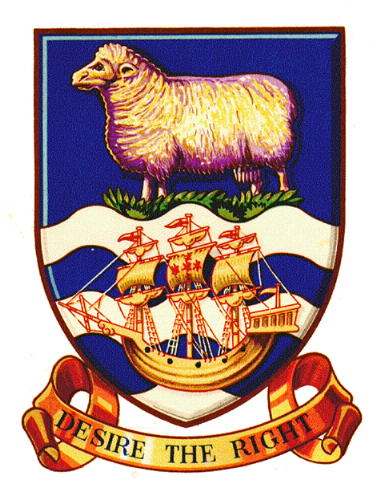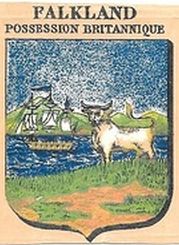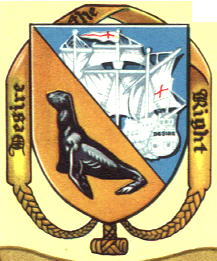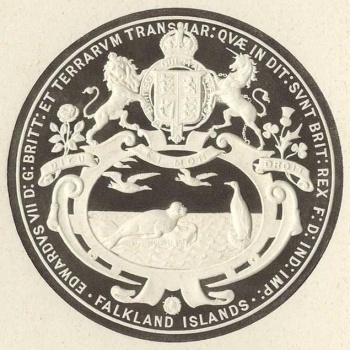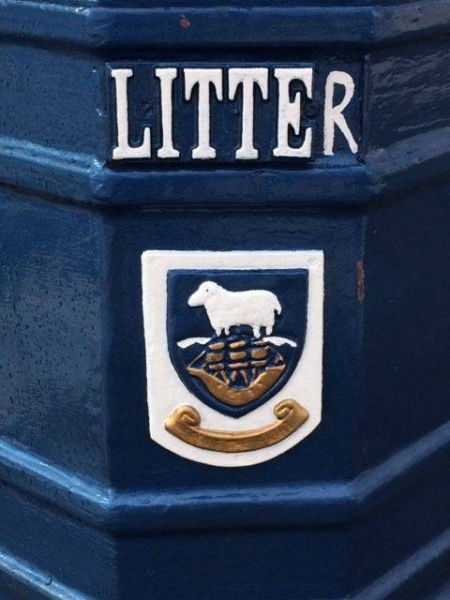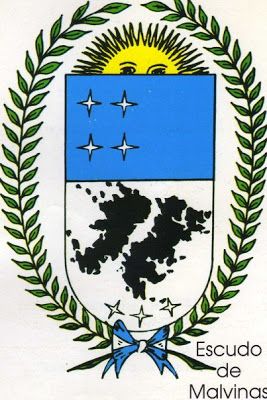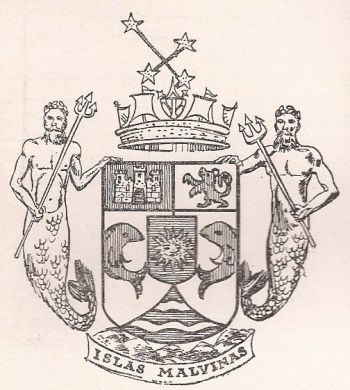National Arms of the Falkland Islands
| Heraldry of the World |
| British heraldry portal Civic heraldry of the United Kingdom |
|
NATIONAL ARMS OF THE FALKLAND ISLANDS
Official blazon
- (1925) Per bend azure and Or, sinister a representation of the ship 'Desire" dimidiated and issuant Argent, flag and pennon charged with a cross gules, and dexter a sea-lion proper. Motto: Desire the Right.
- (1948) Per fesse wavy azure and argent, in chief a hornless ram statant upon Tussac grass issuant proper, and in base two bars wavy of the first, surmounted by a representation of the ship "Desire" Or, the flag and pennons charged with a cross and the mainsail with five estoiles gules; motto: Desire the Right.
Origin/meaning
The arms were granted on September 29, 1948.
The ship represents the DESIRE, the vessel in which the British sea-captain, John Davis, is reputed to have discovered the Falkland Islands in 1592. The motto "Desire the Right" also refers to the ship's name. The Ram represents sheep-farming, until recently the principal economic activity of the Islands and the tussac grass shows the most notable native vegetation.
| The arms on a coin |
The oldest badge of the islands dates from the 1840s. It depicts a ship and a bull. At the time wild cattle were the economic mainstay of the Falklands. It was never an official coat of arms, but was the badge of the seal of the colony.
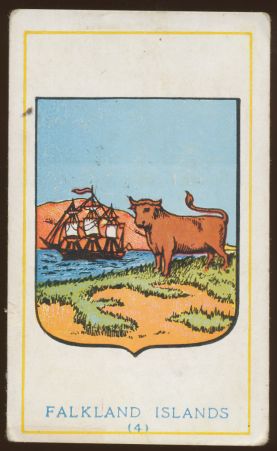 The arms on a tobacco card (1917) |
The arms in a French publication, +/- 1900 |
As cattle were no longer of importance the badge was changed in 1925. The arms show a sea lion as a typical indigenous sea mammal. The ship is again the Desire. These arms are still used as the badge of the Falkland Islands Defence Force.
Below the official seal of the Falkland Islands under the reign of King Edward VII:
Use of the arms:
| The arms on a litter box (2015 (c)Dominique Sinopoli) |
Argentine proposals
Argentina does not recognise the English rule on the islands and considers them part of Argentina as the Islas Malvinas. During the years several Argentine proposals have been made for arms of the islands. Obviously, none of these have actually been used on the islands.
In 1966 the 'National Institute of Falklands and Adjacencies' organised a contest to design arms for the islands. The arms below were declared winner, but the arms were not officially used by the institute:
| The winning design of 1966 |
These arms are explained as follows: The entire upper half is occupied by the Argentine flag, a fact that shows us that the lower Atlantic section is obviously under Argentine jurisdiction (sic). In this lower section, two silver dolphins appear, submerged and aggressive, with their heads down, occupying the upper external and internal corners of the center and right and left corners of the tip, while their bodies, partly approximate, ascend to finish off in its caudal fins without reaching the surface of the sea, leaving enough space between them, occupied by a silver Roman anchor. In addition, three stars in gold appear, with five points each, aesthetically placed, representing the adjacent archipelagos: Georgias, Sandwich and Órcadas del Sur. Outside of the field, a wreath of laurel (right) and olive (left), tied by a ribbon bow with the colors of the Fatherland.
These arms, although not legally approved, have been seen in Argentine publications during the years until present time.
Two other entries from 1966 that have been used/shown during the years :
| Proposal from 1966 by Wildner Fox |
Proposal from 1966 by Humberto Burzio |
In 1969 Jorge de Zarazaga-Berenguer proposed different arms in a general heraldry book for the Argentine market:
| The proposal from 1969 |
These arms are explained as follows: The two dolphins signify the command over the sea that Argentina (represented by the sun from the flag) has over its jurisdictional waters (wavy base) where the Malvinas Islands are (...), as well as love for the entire territory of the nation. The chief is composed with the arms of Castile in the first component and those of León in the second, because these islands are part of the territory discovered and civilized by Spain (...). The naval crown that stamps it and the southern cross that goes as the crest alludes to its marine and southern geographical position. The two mermen supporters express the sovereignty and dominion of the nation over its southern waters, as well as its willingness to defend them.
Contact and Support
Partners:
Your logo here ?
Contact us
© since 1995, Heraldry of the World, Ralf Hartemink 
Index of the site
Literature: Information provided by the Falkland Islands Government Secretariat (govsec.fig@horizon.co.fk), image of the older arms taken from a stamp; Dennys, 1982. Argentine proposals from here


